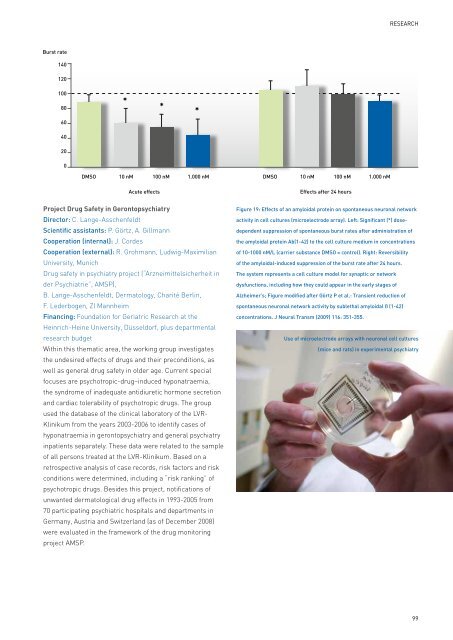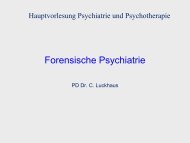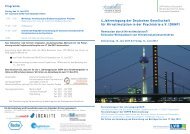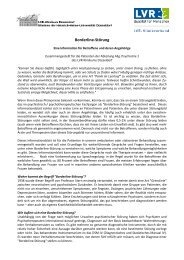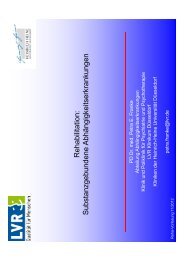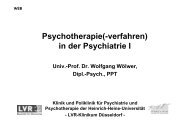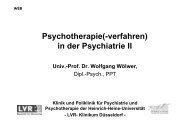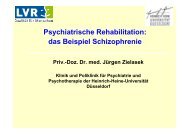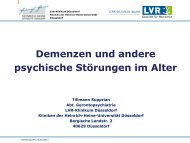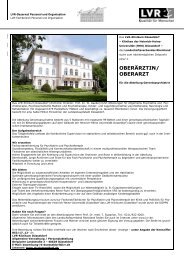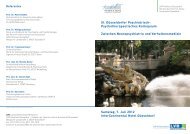LVR-Klinikum Düsseldorf Hospital of the Heinrich-Heine University ...
LVR-Klinikum Düsseldorf Hospital of the Heinrich-Heine University ...
LVR-Klinikum Düsseldorf Hospital of the Heinrich-Heine University ...
Create successful ePaper yourself
Turn your PDF publications into a flip-book with our unique Google optimized e-Paper software.
Burst rate<br />
140<br />
120<br />
100<br />
80<br />
60<br />
40<br />
20<br />
0<br />
*<br />
DMSO 10 nM 100 nM 1.000 nM DMSO 10 nM 100 nM 1.000 nM<br />
Acute effects<br />
Project Drug Safety in Gerontopsychiatry<br />
Director: C. Lange-Asschenfeldt<br />
Scientific assistants: P. Görtz, A. Gillmann<br />
Cooperation (internal): J. Cordes<br />
Cooperation (external): R. Grohmann, Ludwig-Maximilian<br />
<strong>University</strong>, Munich<br />
Drug safety in psychiatry project (“Arzneimittelsicherheit in<br />
der Psychiatrie”, AMSP),<br />
B. Lange-Asschenfeldt, Dermatology, Charité Berlin,<br />
F. Lederbogen, ZI Mannheim<br />
Financing: Foundation for Geriatric Research at <strong>the</strong><br />
<strong>Heinrich</strong>-<strong>Heine</strong> <strong>University</strong>, <strong>Düsseldorf</strong>, plus departmental<br />
research budget<br />
Within this <strong>the</strong>matic area, <strong>the</strong> working group investigates<br />
<strong>the</strong> undesired effects <strong>of</strong> drugs and <strong>the</strong>ir preconditions, as<br />
well as general drug safety in older age. Current special<br />
focuses are psychotropic-drug–induced hyponatraemia,<br />
<strong>the</strong> syndrome <strong>of</strong> inadequate antidiuretic hormone secretion<br />
and cardiac tolerability <strong>of</strong> psychotropic drugs. The group<br />
used <strong>the</strong> database <strong>of</strong> <strong>the</strong> clinical laboratory <strong>of</strong> <strong>the</strong> <strong>LVR</strong>-<br />
<strong>Klinikum</strong> from <strong>the</strong> years 2003-2006 to identify cases <strong>of</strong><br />
hyponatraemia in gerontopsychiatry and general psychiatry<br />
inpatients separately. These data were related to <strong>the</strong> sample<br />
<strong>of</strong> all persons treated at <strong>the</strong> <strong>LVR</strong>-<strong>Klinikum</strong>. Based on a<br />
retrospective analysis <strong>of</strong> case records, risk factors and risk<br />
conditions were determined, including a “risk ranking” <strong>of</strong><br />
psychotropic drugs. Besides this project, notifications <strong>of</strong><br />
unwanted dermatological drug effects in 1993-2005 from<br />
70 participating psychiatric hospitals and departments in<br />
Germany, Austria and Switzerland (as <strong>of</strong> December 2008)<br />
were evaluated in <strong>the</strong> framework <strong>of</strong> <strong>the</strong> drug monitoring<br />
project AMSP.<br />
*<br />
*<br />
Effects after 24 hours<br />
ReseaRch<br />
Figure 19: Effects <strong>of</strong> an amyloidal protein on spontaneous neuronal network<br />
activity in cell cultures (microelectrode array). Left: Significant (*) dosedependent<br />
suppression <strong>of</strong> spontaneous burst rates after administration <strong>of</strong><br />
<strong>the</strong> amyloidal protein Ab(1-42) to <strong>the</strong> cell culture medium in concentrations<br />
<strong>of</strong> 10-1000 nM/L (carrier substance DMSO = control). Right: Reversibility<br />
<strong>of</strong> <strong>the</strong> amyloidal-induced suppression <strong>of</strong> <strong>the</strong> burst rate after 24 hours.<br />
The system represents a cell culture model for synaptic or network<br />
dysfunctions, including how <strong>the</strong>y could appear in <strong>the</strong> early stages <strong>of</strong><br />
Alzheimer’s; Figure modified after Görtz P et al.: Transient reduction <strong>of</strong><br />
spontaneous neuronal network activity by sublethal amyloidal ß (1-42)<br />
concentrations. J Neural Transm (2009) 116: 351-355.<br />
Use <strong>of</strong> microelectrode arrays with neuronal cell cultures<br />
(mice and rats) in experimental psychiatry<br />
99


